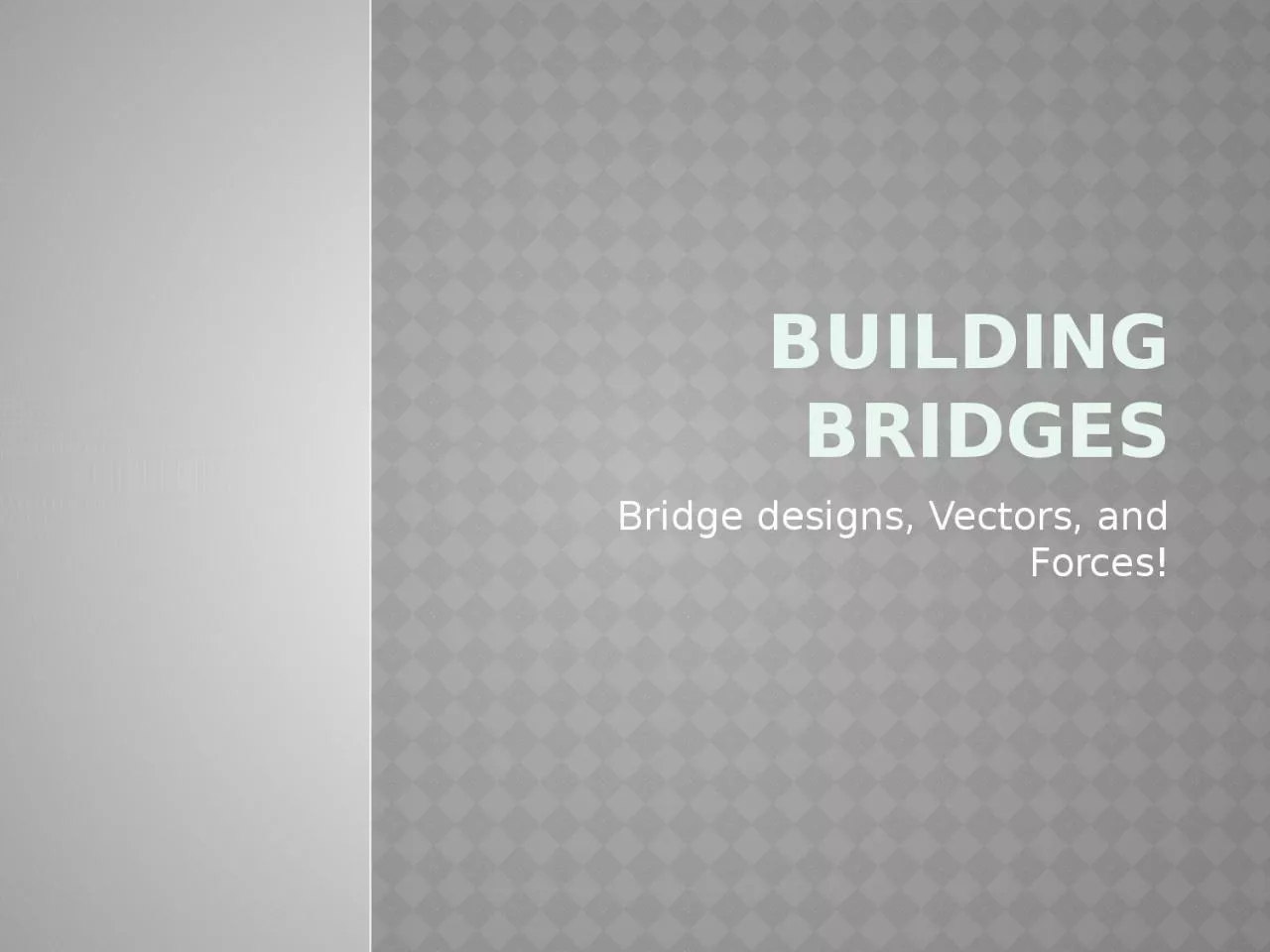

Definition of a BRIDGE A BRIDGE is a structure built to span physical obstacles such as a body of water valley road Designs of bridges vary depending on ID: 998314
Download Presentation The PPT/PDF document "Building Bridges Bridge designs, Vectors..." is the property of its rightful owner. Permission is granted to download and print the materials on this web site for personal, non-commercial use only, and to display it on your personal computer provided you do not modify the materials and that you retain all copyright notices contained in the materials. By downloading content from our website, you accept the terms of this agreement.
1. Building BridgesBridge designs, Vectors, and Forces!
2. Definition of a BRIDGEA BRIDGE is a structure built to span physical obstacles such as a body of water valleyroad Designs of bridges vary depending on the function of the bridgenature of the terrain where the bridge is constructed, the material used to make it and the funds available to build it.
3. FAMOUS BRIDGESFamous Bridges Exploration
4. BEAM BRIDGESOVERVIEW1. Beam bridge structure2. Beam bridge history 3. Beam bridge fun facts
5. BEAM BRIDGE StructureBeam bridges are horizontal beams supported at each end by abutments; hence their structural name of simply supported When there is more than one span the intermediate supports are known as piers or piles.
6. BEAM BRIDGE HISTORYThe earliest beam bridges were simple logs that sat across streams and similar simple structuresIn modern times, beam bridges are large box steel girder bridges. Weight on top of the beam pushes straight down on the abutments at either end of the bridge.THENNOW
7. BEAM BRIDGE FUN FACTS!Beam bridge spans typically do not exceed 250 feet (76 m) long, as the strength of a span decreases with increased length. However, the main span of the Rio-Niteroi Bridge, a box girder bridge, is 300 meters (980 ft.). The world's longest beam bridge is Lake Pontcharatrain Causeway in southern Louisiana in the United States, at 23.83 miles (38.35 km), with individual spans of 56 feet (17 m).Lake Pontcharatrain Causeway
8. TRUSS BRIDGES overview 1. Truss bridge structure2. Truss bridge history3. Truss bridge fun facts!
9. TRUSS BRIDGE StructureA truss bridge is a bridge composed of connected elements (typically straight). These elements may be stressed from tension, compression, or sometimes both in response to dynamic loads.
10. TRUSS BRIDGE HISTORYTruss bridges are one of the oldest types of modern bridges. The basic types of truss bridges have simple designs which could be easily analyzed by nineteenth and early twentieth century engineers.
11. Truss bridge fun facts! A truss bridge is economical to construct owing to its efficient use of materials.
12. SUSPENSION BRIDGES Overview1. Suspension bridge structure2. Suspension bridge history3. Suspension bridge fun facts
13. SUSPENSION BRIDGESSuspension Bridges are suspended from cables. This type of bridge has cables suspended between towers, plus vertical suspender cables that carry the weight of the deck below.Shrek and Donkey
14. SUSPENSION BRIDGE HISTORYThe earliest suspension bridges were made of ropes or vines covered with pieces of bamboo. In modern bridges, the cables hang from towers that are attached to caissons or cofferdams. The caissons or cofferdams are implanted deep into the floor of a lake or river.
15. SUSPENSION bridge fun facts!Light and strong, suspension bridges can span distances from 2,000 to 7,000 feet far longer than any other kind of bridge.They are ideal for covering busy waterways.The 1,991 meters (6,532 feet) Akashi Kaikya Bridge in Japan, also known as the Pearl Bridge, is he longest suspension bridge in the world.Akashi Kaikya
16. VECTORSA VECTOR is not just a number! A vector is a quantity represented by an arrow with magnitude and direction.The symbol for a vector is a capitol letter with a ray above it.Despicable Me: Vector
17. vectorsBridges experience many forces from many different directions. Architects and engineers must take these forces into account during bridge design and construction.The forces that work on bridges will be represented by RED and BLUE vector arrows in the following slides!
18. Vectors & FORCES working on bridges:BEAMWhen something pushes down on the beam, the beam bends. It’s top edge is pushed together, and its bottom edge is pulled apart.TRUSSEvery bar in this bridge experiences either a pushing or pulling force. The bars rarely bend. This is why truss bridges can span farther than beam bridges.SUSPENSIONThe cars push down on the roadway, but because the roadway is suspended, the cables transfer the load into comprehension in the two towers. The two towers support most of the bridge's weight.
19. is the PUSHING force.A shorter piece of wood can withstand more compression force than a longer piece of wood.A longer piece of wood may “buckle” and break from compression.Push!!
20. is the PULLING force!The ability for wood to withstand tension does not depend on the length of the wood.Wood has the ability to resist a lot of tension.Pull!!The vertical cables of a suspension bridge are in tension from the weight of the cars pushing down!
21. Bendingforces cause materials to curve!One end squeezes together while the other side stretches apart!It is a combination of opposite forces.
22. TORSIONis the TWISTING force! Think about it:HOLD ONE END OF A PRETZEL STILL AND TWIST THE OTHER IT WILL BREAK EASILYHOLD ONE END OF A BASEBALL BAT AND TWIST THE OTHER IT WILL NOT BREAK EASILYHOLD ONE END OF A TWIZZLER AND TWIST THE OTHER IS WILL SPIN AND THEN BREAK EVENTUALLYThese are all examples of the TORSION force.
23. SHEARis the SLIDING force!Shear usually occurs horizontally, not vertically.Think “earthquake!”Two pieces of wood may slide against each other in opposite directions.
24. BUILDING BRIDGES Summary! The three types of bridges we covered are BeamTruss &SuspensionVectors show the magnitude and direction of a force on an object.Forces acting on bridges are Compression (pushing)Tension (pulling)BendingTorsion (twisting)Shear (sliding)